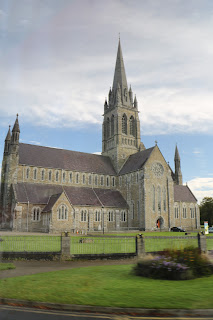Thursday, October 13
Nice breakfast at The Rose hotel in Tralee this morning as menus are given out and orders taken, rather than buffet. They even offered waffles, which were small and seemed to have been dipped in sugar? Took longer but a nice change. Nice rose garden!
We are heading to Killarney this morning, and pass a copper mine which is more than 5,000 years old, dating to the beginning of the Bronze Age! This area had some of the first settlements in Ireland and is where farming began. A little hazy early, but the sun soon breaks through. Still chilly in the 50's.
The Park is at the beginning of the famous Ring of Kerry, but instead of continuing on it, we opt for the Dingle Peninsula, an equally stunning trip with fewer tourists. First we stop at a store called Mackenzies of Ireland for some "quality" shopping. Thankfully we didn't do a lot of this on this tour. They did have lovely jewelry and knit goods, but best of all was the free Irish coffee offered while you shop! I didn't think I would like it, as I'm not a coffee fan, but it didn't taste much like coffee actually and I liked it!
Next we passed through the town of Killorglin, with its statue of King Puck - a proud bronze billy goat. Legend has it that this goat saved the town when Oliver Cromwell's English raiders were headed for Killorglin. King Charles I was a "bad king" who sent his troops including Cromwell into Ireland to "convert" Catholics, but actually killed nearly 60% of the population! (Charles was later beheaded.)The goat supposedly warned the citizens, who were then able to fortify their town and ward off the raiders. They still have a yearly King Puck festival which, from what we heard, can be quite wild.We head onto the Dingle Peninsula and Dingle Bay. The bay, famous for shrimp and mussels, is bordered by sand bars with lots of rocks otherwise. We stop at Inch Beach and walked a bit. On the other side of the sand bar there is surfing where the Atlantic comes ashore. The blue with white squiggles is the sign for the Wild Atlantic Way, a trail that follows the west coast of Ireland.Around 12:30 the fog begins to roll in and visibility drops significantly. When we reach the small port town of Dingle, a heavy rain arrives. So we scurry from shop to shop and instead of lunch, Greg and I opt for Murphy's Ice Cream, which we've been hearing about since Galway. Very tasty and the young man there was quite pleasant. He said they are nearing the end of the season so he was happy for a little company, although they remain open year round while many shops will close. I loved the zig-zaggy center line in the main street!

Nearly everything on Dingle Peninsula is built of stone. Some of the stone walls here have a a crenelated top and a few have a layer of concrete on top to protect it from rain and weather.
There are dozens of shades of green around here! We make reservations at the hotel restaurant for dinner and have a wonderful meal. Beth has a chicken and mushroom pie with a salad and the ever-present chips (fries). Greg has a shrimp and mussels combination in wine sauce. Lovely restaurant is very busy, so glad we made reservations!
























.jpeg)












No comments:
Post a Comment